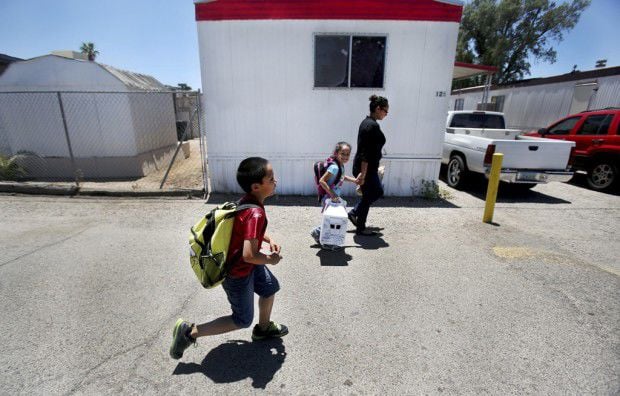If Arizona’s progress were measured on a growth chart, recent years haven’t seen even an inch for the state’s most vulnerable children.
The Annie E. Casey Foundation’s annual Kids Count report finds Arizona failing to keep up with national trends in several categories, most notably child poverty, which has fallen nationwide for four consecutive years and now averages about 19 percent.
Not here.
About 24 percent of Arizona’s children live in poverty, and 23 percent live in neighborhoods with concentrated poverty, which places Arizona in the bottom 10 nationally on both measures, says the 2018 report, released late Tuesday.
Arizona fell from 48th to 49th for share of children living in high-poverty areas, and fell from 30th to 38th for percentage of children growing up in families where parents don’t have full-time, year-round employment.
“We are so far past the recession and so far into economic recovery and yet, and yet, 1 in 4 children are living in poverty,” said Dana Wolfe Naimark, CEO of Arizona’s Children’s Action Alliance.
The alliance describes itself as an independent research and advocacy group that lobbies Arizona lawmakers on policy issues affecting children’s well-being, and provides Arizona data for Kids Count. The Casey Foundation is a private Baltimore-based philanthropy also focused on helping children “at risk of poor educational, economic, social and health outcomes.”
Arizona ranks 45th overall in the Kids Count rankings, which Naimark attributes mostly to poverty, which, for a family of four, means living on $24,600 or less each year. She said poverty is an issue that influences a lot of the other outcomes.
Without addressing the “extreme stress and instability” associated with childhood poverty, Naimark said, the state will continue to see low rankings on well-being while its families and schools struggle.
The Kids Count rankings are based on 16 categories that fall under education, health, poverty, and family and community factors. The new report is mostly based on 2016 data, although some education findings are from 2017.
For economic well-being, Arizona ranked 46th; for education, the ranking was 45th; for health 38th; and for family and community, 46th.
“Arizona has always placed a priority on the well-being and education of children across the state,” said Elizabeth Berry, a spokeswoman for Gov. Doug Ducey, in an email. “While our work is never done to help Arizona’s children, we’ve increased school funding, our economy continues to grow, and the freeze on KidsCare has been lifted.” (KidsCare is a health-care program for the children of Arizona’s working poor.)
New Hampshire ranked first overall in the 2018 Kids Count report. The bottom-ranked states are largely in the South and the Southwest, with New Mexico coming in 50th.
Nationally, the poverty rate among African-American and American Indian children, at 34 percent for both, was almost three times the rate for white and Asian and Pacific Islander children, at 12 percent for both. The poverty rate for Latino children nationally was 28 percent.
Arizona’s gains include the state moving from 39th to 38th for the percentage of children living in single-parent homes. Also, the ranking for teen birth rate moved from 33rd to 32nd.
Other Arizona findings include:
- The share of children in families where the head of household lacks a high school diploma is 17 percent compared to 14 percent nationally.
- The percentage of children in single-parent families is 38 compared to 35 nationally.
- The share of children ages 3-4 who are not attending preschool is 62 percent compared to 52 percent nationally.
- The percentage of fourth-graders who scored below proficient reading level is 70 compared to 65 nationally.
Naimark said Arizona’s policies are failing to help families rise out of poverty. She and other advocates have cited lack of access to affordable child care and Arizona’s strict guidelines for accessing federal support through Temporary Assistance for Needy Families, or TANF, among other issues.
“The hole is so deep and has been dug for so, so long that we’ve got a long way to go to get out,” she said.
The Kids Count data show Arizona children lag in key educational areas including preschool participation, fourth-grade reading and high school graduation. Arizona’s rate for high school graduation is about 79 percent, and the rate nationwide is 84 percent.
Arizona’s eighth-grade students are performing slightly better than the nationwide average in math proficiency, but the state dropped from 18th in the 2015 National Assessment of Educational Progress to 25th in the 2017 test.





